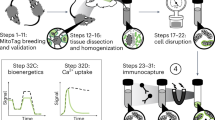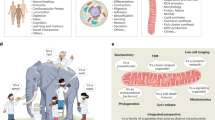Abstract
Many cellular processes require the proper cooperation between mitochondria and the endoplasmic reticulum (ER). Several recent works show that their functional interactions rely on dynamic structural contacts between both organelles. Such contacts, called mitochondria-associated membranes (MAMs), are crucial for the synthesis and intracellular transport of phospholipids, as well as for intracellular Ca2+ signaling and for the determination of mitochondrial structure. Although several techniques are available to isolate mitochondria, only few are specifically tuned to the isolation of MAM, containing unique regions of ER membranes attached to the outer mitochondrial membrane and mitochondria without contamination from other organelles (i.e., pure mitochondria). Here we provide optimized protocols to isolate these fractions from tissues and cells. These procedures require 4–5 h and can be easily modified and adapted to different tissues and cell types.
This is a preview of subscription content, access via your institution
Access options
Subscribe to this journal
Receive 12 print issues and online access
$259.00 per year
only $21.58 per issue
Buy this article
- Purchase on Springer Link
- Instant access to full article PDF
Prices may be subject to local taxes which are calculated during checkout





Similar content being viewed by others
References
Copeland, D.E. & Dalton, A.J. An association between mitochondria and the endoplasmic reticulum in cells of the pseudobranch gland of a teleost. J. Biophys. Biochem. Cytol. 5, 393–396 (1959).
Franke, W.W. & Kartenbeck, J. Outer mitochondrial membrane continuous with endoplasmic reticulum. Protoplasma 73, 35–41 (1971).
Lewis, J.A. & Tata, J.R. A rapidly sedimenting fraction of rat liver endoplasmic reticulum. J. Cell Sci. 13, 447–459 (1973).
Morre, D.J., Merritt, W.D. & Lembi, C.A. Connections between mitochondria and endoplasmic reticulum in rat liver and onion stem. Protoplasma 73, 43–49 (1971).
Vance, J.E. Phospholipid synthesis in a membrane fraction associated with mitochondria. J. Biol. Chem. 265, 7248–7256 (1990).
Ardail, D. et al. Involvement of mitochondrial contact sites in the subcellular compartmentalization of phospholipid biosynthetic enzymes. J. Biol. Chem. 268, 25985–25992 (1993).
Camici, O. & Corazzi, L. Phosphatidylserine translocation into brain mitochondria: involvement of a fusogenic protein associated with mitochondrial membranes. Mol. Cell Biochem. 175, 71–80 (1997).
Shiao, Y.J., Lupo, G. & Vance, J.E. Evidence that phosphatidylserine is imported into mitochondria via a mitochondria-associated membrane and that the majority of mitochondrial phosphatidylethanolamine is derived from decarboxylation of phosphatidylserine. J. Biol. Chem. 270, 11190–11198 (1995).
Zinser, E. et al. Phospholipid synthesis and lipid composition of subcellular membranes in the unicellular eukaryote Saccharomyces cerevisiae . J. Bacteriol. 173, 2026–2034 (1991).
Gaigg, B., Simbeni, R., Hrastnik, C., Paltauf, F. & Daum, G. Characterization of a microsomal subfraction associated with mitochondria of the yeast, Saccharomyces cerevisiae. Involvement in synthesis and import of phospholipids into mitochondria. Biochim. Biophys. Acta. 1234, 214–220 (1995).
Achleitner, G. et al. Association between the endoplasmic reticulum and mitochondria of yeast facilitates interorganelle transport of phospholipids through membrane contact. Eur. J. Biochem. 264, 545–553 (1999).
Rizzuto, R. et al. Close contacts with the endoplasmic reticulum as determinants of mitochondrial Ca2+ responses. Science 280, 1763–1766 (1998).
Mannella, C.A., Buttle, K., Rath, B.K. & Marko, M. Electron microscopic tomography of rat-liver mitochondria and their interaction with the endoplasmic reticulum. Biofactors 8, 225–228 (1998).
Vance, J.E., Stone, S.J. & Faust, J.R. Abnormalities in mitochondria-associated membranes and phospholipid biosynthetic enzymes in the mnd/mnd mouse model of neuronal ceroid lipofuscinosis. Biochim. Biophys. Acta. 1344, 286–299 (1997).
Giorgi, C., De Stefani, D., Bononi, A., Rizzuto, R. & Pinton, P. Structural and functional link between the mitochondrial network and the endoplasmic reticulum. Int. J. Biochem. Cell Biol. 41, 1817–1827 (2009).
Lebiedzinska, M., Szabadkai, G., Jones, A.W.E., Duszynski, J. & Wieckowski, M.R. Interaction between the endoplasmic reticulum, mitochondria, plasma membrane and other subcellular organelles. Int. J. Biochem. Cell Biol. 41, 1805–1816 (2009).
Mendes, C.C. et al. The type III inositol 1,4,5-trisphosphate receptor preferentially transmits apoptotic Ca2+ signals into mitochondria. J. Biol. Chem. 280, 40892–40900 (2005).
Rapizzi, E. et al. Recombinant expression of the voltage-dependent anion channel enhances the transfer of Ca2+ microdomains to mitochondria. J. Cell Biol. 159, 613–624 (2002).
Szabadkai, G. et al. Chaperone-mediated coupling of endoplasmic reticulum and mitochondrial Ca2+ channels. J. Cell Biol. 175, 901–911 (2006).
Hayashi, T. & Su, T.P. Regulating ankyrin dynamics: roles of sigma-1 receptors. Proc. Natl. Acad. Sci. USA 98, 491–496 (2001).
Hayashi, T. & Su, T.P. Sigma-1 receptor chaperones at the ER-mitochondrion interface regulate Ca(2+) signaling and cell survival. Cell 131, 596–610 (2007).
Wu, Z. & Bowen, W.D. Role of sigma-1 receptor C-terminal segment in inositol 1,4,5-trisphosphate receptor activation: constitutive enhancement of calcium signaling in MCF-7 tumor cells. J. Biol. Chem. 283, 28198–28215 (2008).
Higo, T. et al. Subtype-specific and ER lumenal environment-dependent regulation of inositol 1,4,5-trisphosphate receptor type 1 by ERp44. Cell 120, 85–98 (2005).
John, L.M., Lechleiter, J.D. & Camacho, P. Differential modulation of SERCA2 isoforms by calreticulin. J. Cell Biol. 142, 963–973 (1998).
Roderick, H.L., Lechleiter, J.D. & Camacho, P. Cytosolic phosphorylation of calnexin controls intracellular Ca(2+) oscillations via an interaction with SERCA2b. J. Cell Biol. 149, 1235–1248 (2000).
Simmen, T. et al. PACS-2 controls endoplasmic reticulum-mitochondria communication and Bid-mediated apoptosis. EMBO. J. 24, 717–729 (2005).
Wieckowski, M.R. et al. Overexpression of adenine nucleotide translocase reduces Ca2+ signal transmission between the ER and mitochondria. Biochem. Biophys. Res. Commun. 348, 393–399 (2006).
de Brito, O.M. & Scorrano, L. Mitofusin 2 tethers endoplasmic reticulum to mitochondria. Nature 456, 605–610 (2008).
Lebiedzinska, M., Duszynski, J., Rizzuto, R., Pinton, P. & Wieckowski, M.R. Age-related changes in levels of p66Shc and serine 36-phosphorylated p66Shc in organs and mouse tissues. Arch. Biochem. Biophys. 486, 73–80 (2009).
Pinton, P. et al. Protein kinase C beta and prolyl isomerase 1 regulate mitochondrial effects of the life-span determinant p66Shc. Science 315, 659–663 (2007).
Frezza, C., Cipolat, S. & Scorrano, L. Organelle isolation: functional mitochondria from mouse liver, muscle and cultured fibroblasts. Nat. Protoc. 2, 287–295 (2007).
Acknowledgements
Antibody against CNX was a kind gift from Thomas Simmen. This research was supported by the Polish State Committee for Scientific Research (grant N301 092 32/3407), by the Polish Mitochondrial Network for M.R.W., M.L. and J.D. and by AIRC, UMDF, PRRIITT, FISM and Telethon (GGP09128) grants and local funds from the University of Ferrara to P.P.
Author information
Authors and Affiliations
Contributions
All authors contributed extensively to the work presented in this paper. M.R.W., C.G. and M.L. carried out experiments; M.R.W., J.D. and P.P. analyzed data; M.R.W., C.G. and P.P. wrote the paper.
Corresponding authors
Rights and permissions
About this article
Cite this article
Wieckowski, M., Giorgi, C., Lebiedzinska, M. et al. Isolation of mitochondria-associated membranes and mitochondria from animal tissues and cells. Nat Protoc 4, 1582–1590 (2009). https://doi.org/10.1038/nprot.2009.151
Published:
Issue Date:
DOI: https://doi.org/10.1038/nprot.2009.151
This article is cited by
Proteomic analysis of mitochondria associated membranes in renal ischemic reperfusion injury
Journal of Translational Medicine (2024)
Enhanced branched-chain amino acid metabolism improves age-related reproduction in C. elegans
Nature Metabolism (2024)
Impairment of electron transport chain and induction of apoptosis by chrysin nanoparticles targeting succinate-ubiquinone oxidoreductase in pancreatic and lung cancer cells
Genes & Nutrition (2023)
Mitochondrial Lon-induced mitophagy benefits hypoxic resistance via Ca2+-dependent FUNDC1 phosphorylation at the ER-mitochondria interface
Cell Death & Disease (2023)
Reducing lipid peroxidation attenuates stress-induced susceptibility to herpes simplex virus type 1
Acta Pharmacologica Sinica (2023)
Comments
By submitting a comment you agree to abide by our Terms and Community Guidelines. If you find something abusive or that does not comply with our terms or guidelines please flag it as inappropriate.



